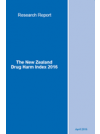The New Zealand Drug Harm Index 2016 estimates the social cost of drug-related harms and intervention costs in 2014/15 as NZ$1.8 billion.
The total cost of illicit drug use has been considered as having three components.
- The cost of personal harm, that is, the harms that descend upon an individual as a consequence of their drug use. This will comprise physical health, psychological wellbeing and personal wealth.
- The cost of community harm, that is, the cost of crime attributable to drug use, injury to others, the various harms to family and friends and a reduced tax base.
- The cost of interventions by agencies that occur as a result of attempts to address the harms associated with illicit drug use and include health, education and law enforcement.
Overall, the social cost of drug use is estimated at NZ$33,800 per year per dependent user and NZ$2,300 per year per casual user.
The cost to the family and friends of drug users is identified in this report for the first time. An emerging literature exists on this topic which has formed the basis of a cost estimate of the pain and suffering endured by family and friends at $438 million. This is the single largest cost estimate in the 2016 DHI model.
The DHI estimates that the Government is spending at least $230 million each year to address a $1.8 billion problem. It should be possible to improve the transparency of this expenditure over time. Government agencies vary in their ability to report their expenditure on drug-related matters. It is probable that the current figure is an underestimate of real expenditure.
An estimate of the true cost of drug-related crime is included for the first time in any DHI. While previous DHIs have included the cost of combating crime within the general category of crime, this new classification identifies three types of drug-related crime:
- acquisitive crime by users to support their drug use (NZ$140 million)
- funding of non-drug related crime types from the proceeds of drug trafficking as part of the diversification of organised crime’s business interest (NZ$70 million)
- tax avoidance on the revenue raised from the sale of illegal drugs (NZ$254 million).
This Drug Harm index was commissioned by the Ministry of Health. The original New Zealand DHI published in 2008 provided law enforcement with a way of reporting drug seizure activity in a single meaningful number that also represented the dollar value of its social impact to the community.
Although the DHI was originally developed in a law enforcement context, it was soon recognised that a single index would be of value in tracking the total harm caused by illicit drugs.
Methodology
The method involved identifying the number of drug users and the extent of drug use by category of drug. Where hard data existed (e.g. drug-related deaths, treatment sessions, crime statistics), the estimated harm was calculated for given drug types. In the absence of hard data, expert opinion (following a method developed by Nutt et al, 2010) was used to provide a basis for the future estimate of the dollar harms for drugs. Unlike previous drug harm indexes, the social cost of harm associated with drug use (personal harm and community harm) was separated from the costs associated with attempts to address the issue (intervention costs). Cost estimates included explicitly for the first time include harm to family and friends of drug users, funding of other criminal activities and reduction in taxation revenue.
Key Results
The estimated social cost of drug-related harms and intervention costs in 2014/15 was $1.8 billion. Details are given below.
|
Drug group |
Personal harm $(m) |
Community harm $(m) |
Total harm $(m) |
Intervention cost $(m) |
Total social cost $(m) |
|
Amphetamine-type stimulants |
256.4 |
91.4 |
347.8 |
16.4 |
364.2 |
|
Cannabinoids |
256.4 |
720.3 |
976.7 |
305.9 |
1,282.6 |
|
Hallucinogenic and psychedelic drugs |
8.0 |
9.0 |
17.0 |
5.3 |
22.3 |
|
Opioid and sedative drugs |
80.1 |
72.0 |
152.1 |
23.8 |
175.9 |
|
Total |
601.0 |
892.7 |
1,493.7 |
351.4 |
1,845.0 |
The new Drug Harm Index is a conservative measure of the harms associated with the use of illicit drugs in New Zealand. The Index can be extended to accommodate new and emerging drugs into the Index in the future. This method will also extend the useful life of the proposed Drug Harm Index. It provides new insights into who actually suffers from the burden imposed by illicit drug use.

